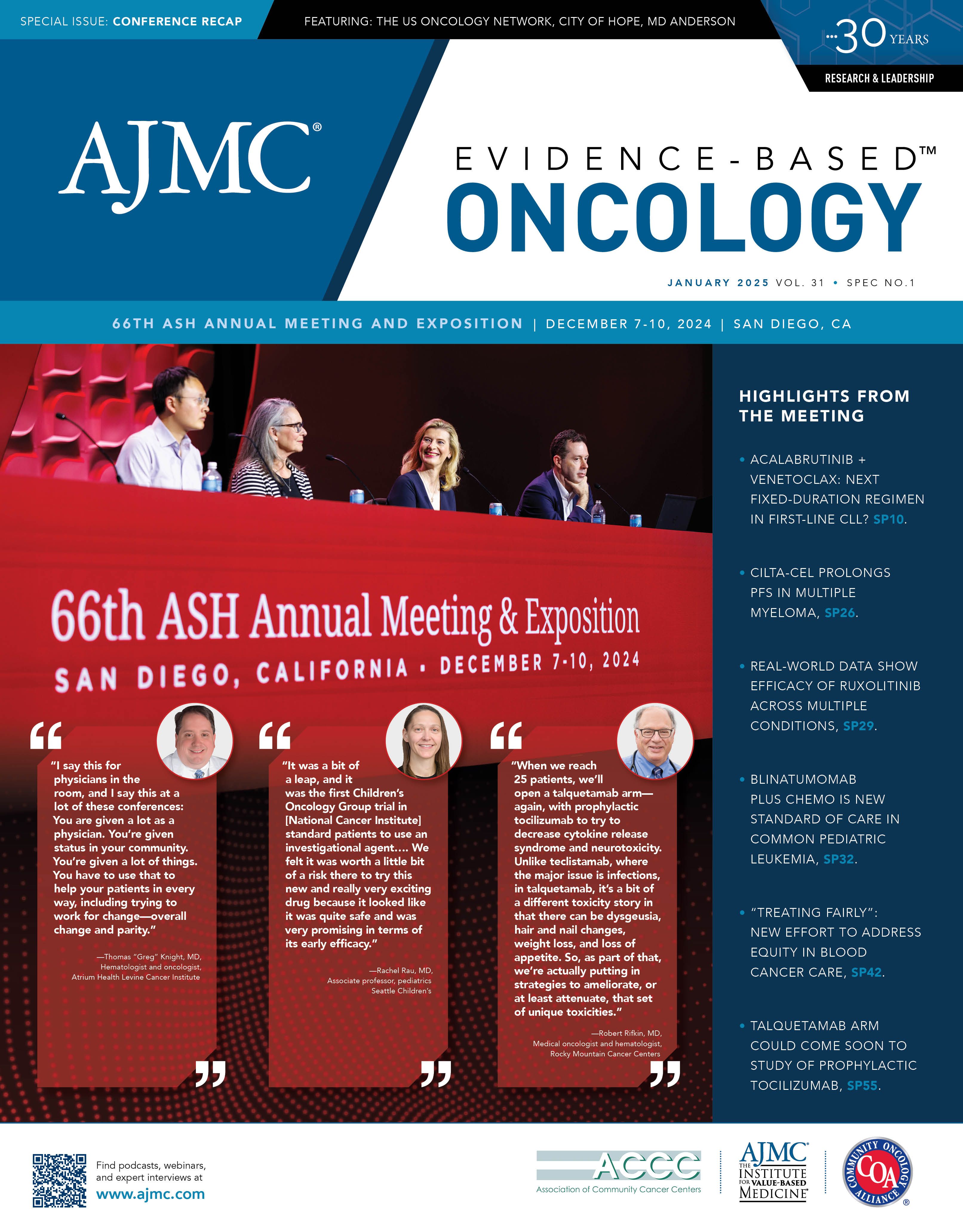Publication
Article
Evidence-Based Oncology
SPOTLIGHT: Zanubrutinib’s Safety Profile in CLL Reinforced in 5-Year Follow-Up of SEQUOIA
Author(s):
Key Takeaways
- Zanubrutinib shows sustained superior PFS in CLL patients without del(17p), regardless of IGHV mutation status.
- The safety profile of zanubrutinib remains consistent, with low atrial fibrillation rates and no new safety signals.
The phase 3 SEQUOIA study’s 5-year follow-up (NCT03336333) of a cohort of patients with treatment-naive chronic lymphocytic leukemia (CLL) without del(17p) demonstrated zanubrutinib’s sustained superior progression-free survival (PFS) compared with bendamustine plus rituximab (Rituxan; Genentech).1 Zanubrutinib (Brukinsa; BeiGene) showed a significant improvement in PFS, regardless of IGHV mutation status. The safety profile remained consistent, with low rates of atrial fibrillation and no new safety signals, reinforcing zanubrutinib’s role as a standard frontline therapy.
In an interview with The American Journal of Managed Care (AJMC), Mazyar Shadman, MD, MPH, discussed the safety profile of zanubrutinib compared with other Bruton tyrosine kinase (BTK) inhibitors. Shadman is the Innovators Network Endowed Chair and an associate professor in the Clinical Research Division at Fred Hutch Cancer Center, and an associate professor in the Medical Oncology Division at the University of Washington School of Medicine, both in Seattle, Washington.
Shadman presented the 5-year follow-up data at the 66th American Society of Hematology Annual Meeting and Exposition, held December 7-10, 2024, in San Diego, California.
AJMC: What is the importance of zanubrutinib’s safety profile related to cardiovascular events compared with other BTK inhibitors?
Shadman: When we talk about comparing with other BTK inhibitors, we should remember that it’s very difficult to talk about it outside of the head-to-head randomized trials. The only study in CLL that we have in terms of comparing zanubrutinib with ibrutinib is ALPINE [phase 3; NCT03734016], and in that study, one of the main secondary end points was cumulative incidence of cardiovascular events.2 Zanubrutinib was associated with a lower rate of AFib [atrial fibrillation] and atrial flutter, lower rate of cardiovascular events, [and] no report of grade 5 cardiac events, which was great. The rate of hypertension was not different compared with ibrutinib, but that did not translate to a higher cardiovascular end point. That’s the head-to-head trial in CLL.
We have a head-to-head trial in Waldenström [macroglobulinemia] with the ASPEN trial [phase 3; NCT03053440] that kind of showed the same.3 In addition to the rate of hypertension, that was also lower compared with ibrutinib. From SEQUOIA, all we can say is that, compared with chemotherapy, the exposure-adjusted risks of AFib, and hypertension—the 2 big adverse events of interest cardiac-wise—were pretty similar to the chemotherapy arm and chemotherapy. If you think about it, that would be the background risk for the population that enrolled in this study, which is similar—from the age and comorbidity standpoint—to what we see in practice. The numbers look really close to what you see with non–BTK inhibitor therapy. I think that’s important now.
You have to do a head-to-head randomized trial to compare zanubrutinib versus acalabrutinib (Calquence, AstraZeneca) or pirtobrutinib (Jaypirca; Lilly) to make specific comments about the relative cardiac safety, [but] we don’t have that data.
AJMC: Given that zanubrutinib and other BTK inhibitors are taken indefinitely for CLL, how does the safety profile take on new importance?
Shadman: At 5 years of follow-up, 68% of patients are still taking the drug. There’s a very good chance that, with longer follow-up, a high percentage of patients are still taking these drugs. When you talk to a patient before [they start taking] zanubrutinib, they want to know how well the drug works, but they also want to know what [adverse] effects they should be expecting 3, 4, 5, 6, 10 years later. And that’s why data like [those from] the long-term follow-up of studies like SEQUOIA are extremely important. We discussed that we’re not seeing any new safety signals, and if anything, the adverse events that we commonly think about are not alarming at this time, with this current follow-up, at least.
References
1. Shadman M, Munir T, Robak T, et al. Sustained superiority of zanubrutinib vs bendamustine + rituximab in treatment-naive chronic lymphocytic leukemia/small lymphocytic lymphoma (TN CLL): 5-year follow-up of cohort 1 from the SEQUOIA study. Presented at: 66th American Society of Hematology Annual Meeting and Exposition; December 7-10, 2024; San Diego, CA. Abstract 3249.
2. Brown JR, Eichhorst B, Hillmen P, et al. Zanubrutinib or ibrutinib in relapsed or refractory chronic lymphocytic leukemia. N Engl J Med. 2023;388(4):319-332. doi:10.1056/NEJMoa2211582
3. Tam CS, Opat S, D’Sa S, et al. A randomized phase 3 trial of zanubrutinib vs ibrutinib in symptomatic Waldenström macroglobulinemia: the ASPEN study. Blood. 2020;136(18):2038-2050. doi:10.1182/blood.2020006844






